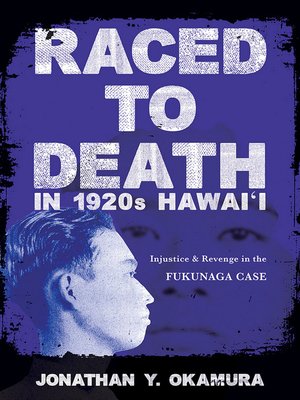Raced to Death in 1920s Hawai'i
ebook ∣ Injustice and Revenge in the Fukunaga Case · Asian American Experience
By Jonathan Y Okamura

Sign up to save your library
With an OverDrive account, you can save your favorite libraries for at-a-glance information about availability. Find out more about OverDrive accounts.
Find this title in Libby, the library reading app by OverDrive.



Search for a digital library with this title
Title found at these libraries:
| Library Name | Distance |
|---|---|
| Loading... |
On September 18, 1928, Myles Yutaka Fukunaga kidnapped and brutally murdered ten-year-old George Gill Jamieson in Waikîkî. Fukunaga, a nineteen-year-old nisei, or second-generation Japanese American, confessed to the crime. Within three weeks, authorities had convicted him and sentenced him to hang, despite questions about Fukunaga's sanity and a deeply flawed defense by his court-appointed attorneys. Jonathan Y. Okamura argues that officials "raced" Fukunaga to death—first viewing the accused only as Japanese despite the law supposedly being colorblind, and then hurrying to satisfy the Haole (white) community's demand for revenge. Okamura sets the case against an analysis of the racial hierarchy that undergirded Hawai'ian society, which was dominated by Haoles who saw themselves most threatened by the islands' sizable Japanese American community. The Fukunaga case and others like it in the 1920s reinforced Haole supremacy and maintained the racial boundary that separated Haoles from non-Haoles, particularly through racial injustice. As Okamura challenges the representation of Hawai i as a racial paradise, he reveals the ways Haoles usurped the criminal justice system and reevaluates the tense history of anti-Japanese racism in Hawai i.|
Cover
Title Page
Copyright
Contents
Preface
Introduction
1. The Racial Setting of Hawai'i in the 1920s
2. Kidnapping, Killing, and Racial Profiling
3. Capture, Confession, and Court
4. Racial Bias and Injustice in Jury Selection and Trial
5. The Insanity Question
6. Aftermath of Death Sentence: Racial, Legal, and Community
Conclusion: Fukunaga and Kahahawai
Notes
References
Index
Back cover
|
"The color line in the United States has historically been and continues to be White vs. Black, yet the salient strength of Raced to Death is to make evident that the color line is, more accurately, White vs. Non-White."—Karen L. Ishizuka, author of Serve the People: Making Asian America in the Long Sixties
"Okamura's work opens the door for further reflection on how this history fits into larger patterns of U.S. race relations." —Nichi Bei Weekly
"A fascinating account linking racism to colonialism, labor, and criminal justice in an unexpected setting. Okamura's book makes it impossible to forget Hawai i when studying comparative race and ethnic relations."—Lon Kurashige, author of Two Faces of Exclusion: The Untold History of Anti-Asian Racism in the United States
|Jonathan Y. Okamura is a professor in the Department of Ethnic Studies at the University of Hawai i. He is the author of several books, most recently From Race to Ethnicity: Interpreting Japanese American Experiences in Hawai i.
"Okamura's work opens the door for further reflection on how this history fits into larger patterns of U.S. race relations." —Nichi Bei Weekly
"A fascinating account linking racism to colonialism, labor, and criminal justice in an unexpected setting. Okamura's book makes it impossible to forget Hawai i when studying comparative race and ethnic relations."—Lon Kurashige, author of Two Faces of Exclusion: The Untold History of Anti-Asian Racism in the United States
|Jonathan Y. Okamura is a professor in the Department of Ethnic Studies at the University of Hawai i. He is the author of several books, most recently From Race to Ethnicity: Interpreting Japanese American Experiences in Hawai i.







